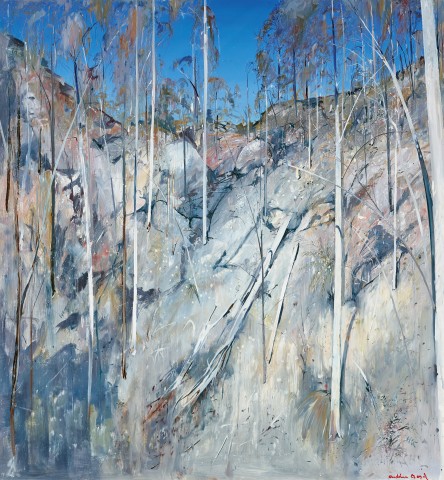SHOALHAVEN HILLSIDE, c. 1974 – 76
ARTHUR BOYD
oil on composition board
96.5 x 89.0 cm
signed lower right: Arthur Boyd
The Estate of Peter Greenham, Melbourne
Eager to rediscover his roots, his 'Australianism', after more than a decade abroad, in 1971 Arthur Boyd returned to Australia to take up a Creative Arts Fellowship at the Australian National University in Canberra. Over that blazing summer of 1971 – 72, Boyd and his wife Yvonne were invited by the Sydney art dealer Frank McDonald to visit Bundanon for the weekend, a home he shared on the south coast of New South Wales with art historian Sandra McGrath and her husband Tony. Here the artist’s joyful rediscovery of the Australian bush with its stark contrasts and clarity of light was nothing short of an epiphany, and thus in 1974, Boyd purchased the nearby property Riversdale on the banks of the Shoalhaven River. Once again the magic of the dour, untamed Australian landscape became the impetus for his art, and over the subsequent twenty-five years until his death in 1999, Boyd would dedicate himself almost exclusively to capturing the myriad moods of the Shoalhaven in images that are today imprinted upon the national psyche as some of our most beloved and iconic.
Soul-piercing in its beauty, the Shoalhaven region offered infinite potential as a subject – 'the variation in the area with its great deep tones and high keys' bearing strong affinities with music. As Boyd elaborated, '...in the desert there is only one note, just one low singing note. In this landscape the tonal range – not tonal in the obvious sense of colour, but the actual fact of the horizon which can vary from very high to low to infinite, depending on your line of vision – makes it a greater challenge. It has a knife-edged clarity. Impressionism could never have been born here, but Wagner could easily have composed here.'1 Wild and primordial, the region differed completely from the ordered English countryside to which he had grown accustomed and thus, a new vision was required to unlock its tangled mysteries. If previously Breughel and Rembrandt had offered inspiration, now Von Guerard, Piguenit and Buvelot became Boyd's spiritual mentors; as he mused, 'I see the landscape looking very much like a Von Guerard, much more than the look of the Australian Impressionist school. In this area you are aware again and again how those old boys got it right all the time.'2
Suffused with warmth and lyricism, Shoalhaven Hillside, c.1974 – 76 is an exquisitely painted example of the 'pure' Shoalhaven landscapes which - devoid of the mythological creatures and symbolic narrative punctuating versions elsewhere – simply celebrate Nature in all her beauty and grandeur. Indeed, the work is a poignant reminder of how Boyd, comfortable once more with the eternal diversity of the Australian landscape, ultimately did tame his wilderness - '...what was unfamiliar became familiar, what was menacing became friendly, what was awesome became intimate.'3
1. Boyd cited in Pearce, B., Arthur Boyd Retrospective, Art Gallery of New South Wales, Sydney, 1993, pp. 26 – 27
2. Boyd cited in McGrath, S., The Artist and the Shoalhaven, Bay Books, Sydney, 1982, p. 220
3. McGrath, ibid., p.79
VERONICA ANGELATOS
